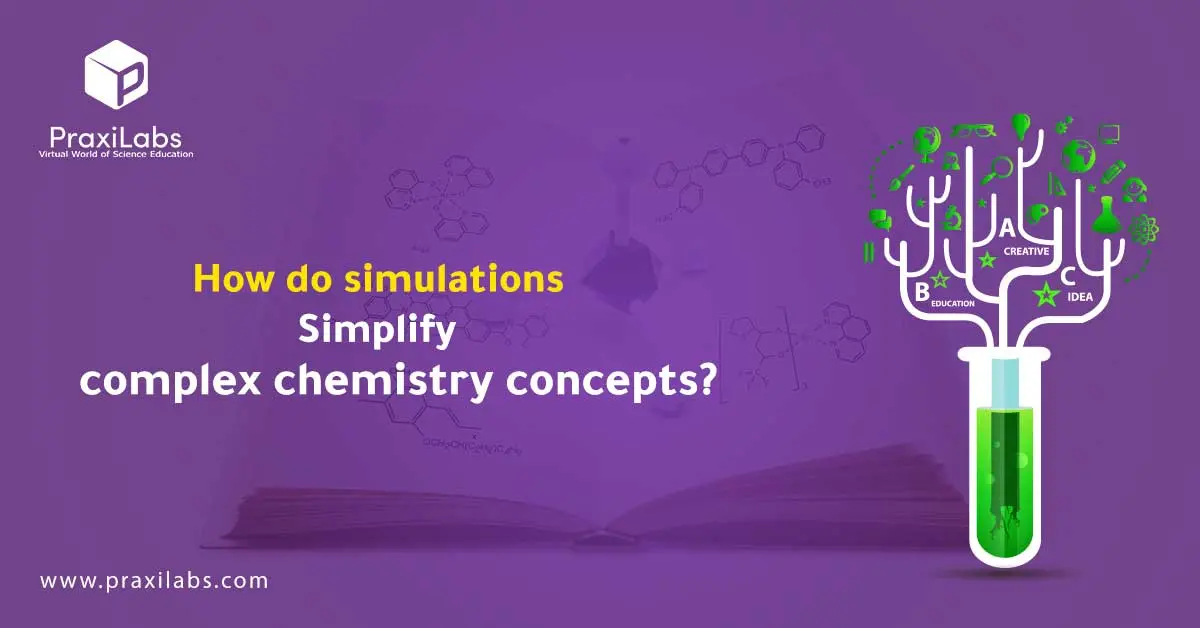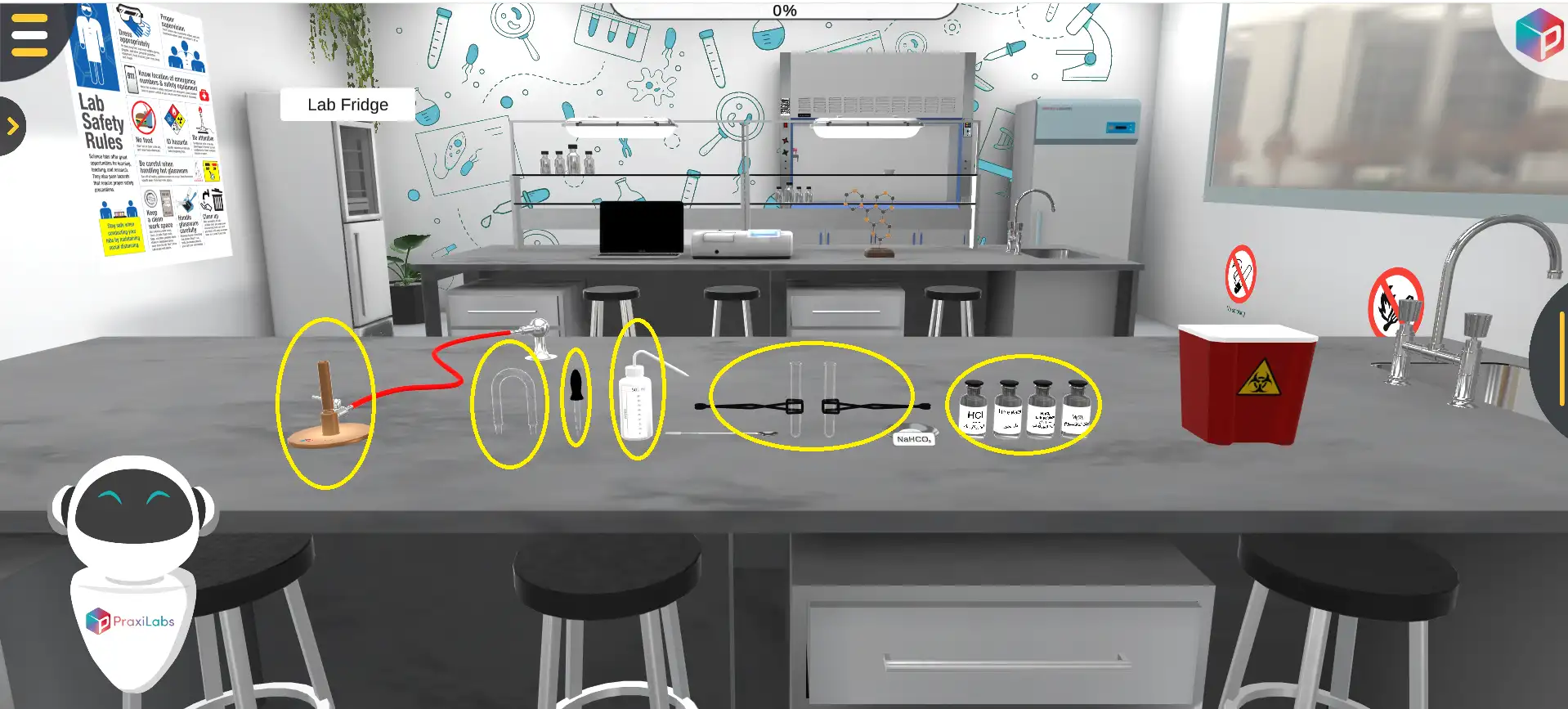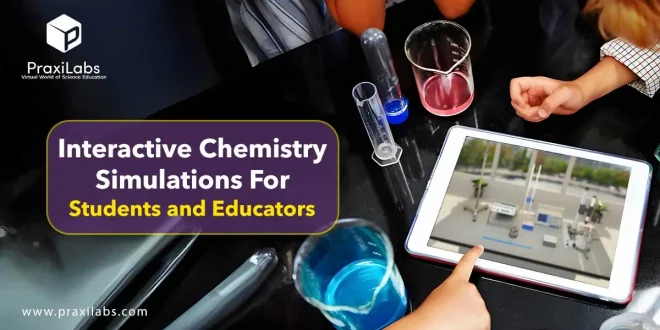Last Updated on August 7, 2025 by Muhamed Elmesery
Virtual lab simulations are becoming an essential tool in the fast-changing educational landscape, especially in the subject of chemistry. Interactive chemistry simulations are beneficial because they guarantee student safety, enhance learning outcomes, and provide educational institutions with affordable alternatives.
In this blog post, we will discover the world of online chemistry simulations, how do simulations simplify complex chemistry concepts, which topics you can learn through chemistry simulation online, whether online simulations are suitable for all educational levels, a discussion about whether “interactive simulations will end the existence of real labs?”, and more!
Table of Contents
What is meant by interactive chemistry simulations?
Interactive chemistry simulations are a visual and immersive way to learn chemistry online. These simulations are computer-based that allow students to understand several concepts clearly by conducting their chemistry experiments online using interactive virtual labs with the following features:
- Visualizing invisible chemistry concepts and phenomena.
- Safe environment.
- Cost-effective.
- Interactive Learning.
- Flexible.
- Repeatable.

How do simulations simplify complex chemistry concepts?
interactive chemistry simulations simplify complex concepts by providing immersive and interactive virtual labs for these concepts and theories, allowing students to explore and enhance their learning outcomes by facilitating a deeper understanding of various chemistry topics.
According to research, including specific laboratory learning objectives in virtual labs improves learning outcomes and student performance.
With benefits including modeling chemical processes and facilitating instructional experiments, virtual chemical laboratories are essential for helping students develop their experimental problem-solving abilities in chemistry.
Additionally, the introduction of animated graphic learning resources in virtual labs increases students’ intrinsic motivation, and lab performance is further improved by repeated experimentation and interaction with instructors.
Visit Our Ever-Expanding Catalog of 3D science experiments and Enhance Your Students’ Learning Outcomes!
What topics can you learn through chemistry simulations?
Interactive chemistry simulations can be used to learn a wide range of topics, from foundational concepts to advanced subjects. These include:
Analytical chemistry
Teach your students how to identify, differentiate, separate, quantify, and measure concentration of matter.
You can find simulations cover topics such as:
- Acid – base titration.
- Chromatography.
- Redox titration.
- Qualitative analysis.
- Quantitative analysis.
- Gravimetric analysis virtual lab.
- Colorimetry.

Inorganic chemistry
Your students will learn and understand various properties and reactions of inorganic compounds and elements.
You can find inorganic chemistry simulations cover topics such as:
- Identification for acid radicals.
- Identification for basic radicals.
- Flame test.
Organic chemistry
Your students will explore the structure, properties, synthesis, and reactions of organic compounds (carbon-containing compounds).
- You can find organic chemistry simulations cover topics such as:
- Detection of Functional Groups (alcohols, aldehydes, ketones).
- Synthesis reactions.
- Saponification reactions.
- Esterification Reactions.
- Identification of Carbohydrates, Fats, and Proteins.
Physical chemistry
Teach your students principles and concepts that connect chemistry with physics (e.g., thermodynamics, chemical kinetics).
You can find physical chemistry simulations cover topics such as:
- Spectroscopy.
- Rate of Reaction.
- Effect of Temperature and Concentration.
- Heat of Reaction (Calorimetry).
- PH Measurements and Buffer Solutions.
Safety and Lab Skills
Safety lab simulation will help your students:
Learn all safety instructions and precautions regarding working in a chemical lab.
- Understand safety signs.
- Read and interpret material safety data sheets.
- Practice a real experiment applying safety measures.
- Identify correct and incorrect actions in a science lab.
- Decide what to do if small accidents should happen.
Are online simulations suitable for any educational level?
Yes, online simulations are suitable for a wide range of educational levels, from primary school to higher education and even post-graduate education.
The key is to adapt the complexity and content of the simulation to the specific learning objectives and developmental stage of the students.
Before using online simulation, make sure that you:
- Identify and define your learning objectives (what you want your students to learn by using virtual labs).
- Choose an appropriate platform that provides virtual lab simulations for students aligned with your goals.
- Familiarize yourself with the virtual lab simulations, try them yourself, and prepare any learning materials you may need.
Will interactive simulations end the existence of real labs?
According to a study conducted on the role of computer-based materials for the teaching of developmental biology in order to aid teachers in assessing their value, despite digital tools having value, they should not replace all of the real laboratory activities.
Clearly, both virtual labs and real labs must be included in laboratory exercises. Relying solely on one or the other is not appropriate.
What is the top platform for chemistry simulations in USA?
PraxiLabs is one of the top platforms for chemistry simulations. Our virtual chemistry lab simulator online offers a variety of experiments that improve learning through hands-on, interactive experiences across key chemistry fields, including:
- Analytical Chemistry (like titration and chromatography).
- Inorganic Chemistry (acid and base radical analysis).
- Organic Chemistry (including tests for functional groups.
- Essential lab safety and basic skills training.
PraxiLabs functions as an effective alternative for conventional laboratory environments in the face of budgetary and resource limitations, ensuring that students receive comprehensive and hands-on chemistry education.
A case study of finding the concentration of silver nitrate using Fajans titration method demonstrates how PraxiLabs virtual labs may accurately mimic difficult scientific processes, offering students a valuable educational experience that gets them ready for further scientific endeavors.
PraxiLabs provides instant and unlimited access to several simulations you may need from anywhere, without the hassle of going to the laboratory. Let your young scientists enjoy their journey, anytime!
Frequently Asked Questions
What is the best way online to learn chemistry?
Interactive chemistry simulation is the best way online to learn chemistry, you can perform your experiments any time, anywhere, several times in a safe and immersive environment that mimics real chemistry labs.
What are the benefits of using digital simulations for science education?
The key benefit of using digital simulations for science education is to gain a clear understanding by imagining and visualizing everything you study. This enhances the students’ visual perception and observational skills.
Other benefits include:
- Hands on simulation of Real-Life Lab Procedures.
- Safe and Risk-Free Environment.
- Interactive Learning Experience.
- Reproducibility and Repetition.
- Cost effective.
 PraxiLabs A virtual world of science
PraxiLabs A virtual world of science






